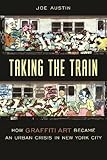Taking the Train : How Graffiti Art Became an Urban Crisis in New York City / Joe Austin.
Material type: TextSeries: Princeton Classic EditionsPublisher: New York, NY : Columbia University Press, [2002]Copyright date: ©2002Description: 1 online resource (400 p.) : 40 illus (23 in color)Content type:
TextSeries: Princeton Classic EditionsPublisher: New York, NY : Columbia University Press, [2002]Copyright date: ©2002Description: 1 online resource (400 p.) : 40 illus (23 in color)Content type: - 9780231111423
- 9780231533881
- 081 21
- GT3913.N72 N415 2001eb
- online - DeGruyter
- Issued also in print.
| Item type | Current library | Call number | URL | Status | Notes | Barcode | |
|---|---|---|---|---|---|---|---|
 eBook
eBook
|
Biblioteca "Angelicum" Pont. Univ. S.Tommaso d'Aquino Nuvola online | online - DeGruyter (Browse shelf(Opens below)) | Online access | Not for loan (Accesso limitato) | Accesso per gli utenti autorizzati / Access for authorized users | (dgr)9780231533881 |
Browsing Biblioteca "Angelicum" Pont. Univ. S.Tommaso d'Aquino shelves, Shelving location: Nuvola online Close shelf browser (Hides shelf browser)

|

|

|

|

|

|

|
||
| online - DeGruyter Decoding Al-Qaeda's Strategy : The Deep Battle Against America / | online - DeGruyter Living on the Edge : The Realities of Welfare in America / | online - DeGruyter The Columbia Anthology of Traditional Korean Poetry / | online - DeGruyter Taking the Train : How Graffiti Art Became an Urban Crisis in New York City / | online - DeGruyter The Achievement of American Liberalism : The New Deal and Its Legacies / | online - DeGruyter Roger Nash Baldwin and the American Civil Liberties Union / | online - DeGruyter Negotiating Culture and Human Rights / |
Frontmatter -- Contents -- Prologue -- 1. A Tale of Two Cities -- 2. Taking the Trains: The Formation and Structure of "Writing Culture" in the Early 1970s -- 3. Writing "Graffiti" in the Public Sphere: The Construction of Writing as an Urban Problem -- 4. Repainting the Trains: The New York School of the 1970s -- 5. The State of the Subways: The Transit Crisis, the Aesthetics of Fear, and the Second "War on Graffiti" -- 6. Writing Histories -- 7. Retaking the Trains -- 8. The Walls and the World:Writing Culture, 1982-1990 -- Conclusion: A Spot on the Wall -- Appendix: Sources from Writers -- Notes -- Selected Bibliography -- Acknowledgments -- Index
restricted access online access with authorization star
http://purl.org/coar/access_right/c_16ec
In the 1960s and early 1970s, young people in New York City radically altered the tradition of writing their initials on neighborhood walls. Influenced by the widespread use of famous names on billboards, in neon, in magazines, newspapers, and typographies from advertising and comics, city youth created a new form of expression built around elaborately designed names and initials displayed on public walls, vehicles, and subways. Critics called it "graffiti," but to the practitioners it was "writing." Taking the Train traces the history of "writing" in New York City against the backdrop of the struggle that developed between the city and the writers. Austin tracks the ways in which "writing"- a small, seemingly insignificant act of youthful rebellion-assumed crisis-level importance inside the bureaucracy and the public relations of New York City mayoral administrations and the Metropolitan Transportation Authority for almost two decades. Taking the Train reveals why a global city short on funds made "wiping out graffiti" an expensive priority while other needs went unfunded. Although the city eventually took back the trains, Austin eloquently shows how and why the culture of "writing" survived to become an international art movement and a vital part of hip-hop culture.
Issued also in print.
Mode of access: Internet via World Wide Web.
In English.
Description based on online resource; title from PDF title page (publisher's Web site, viewed 02. Mrz 2022)


